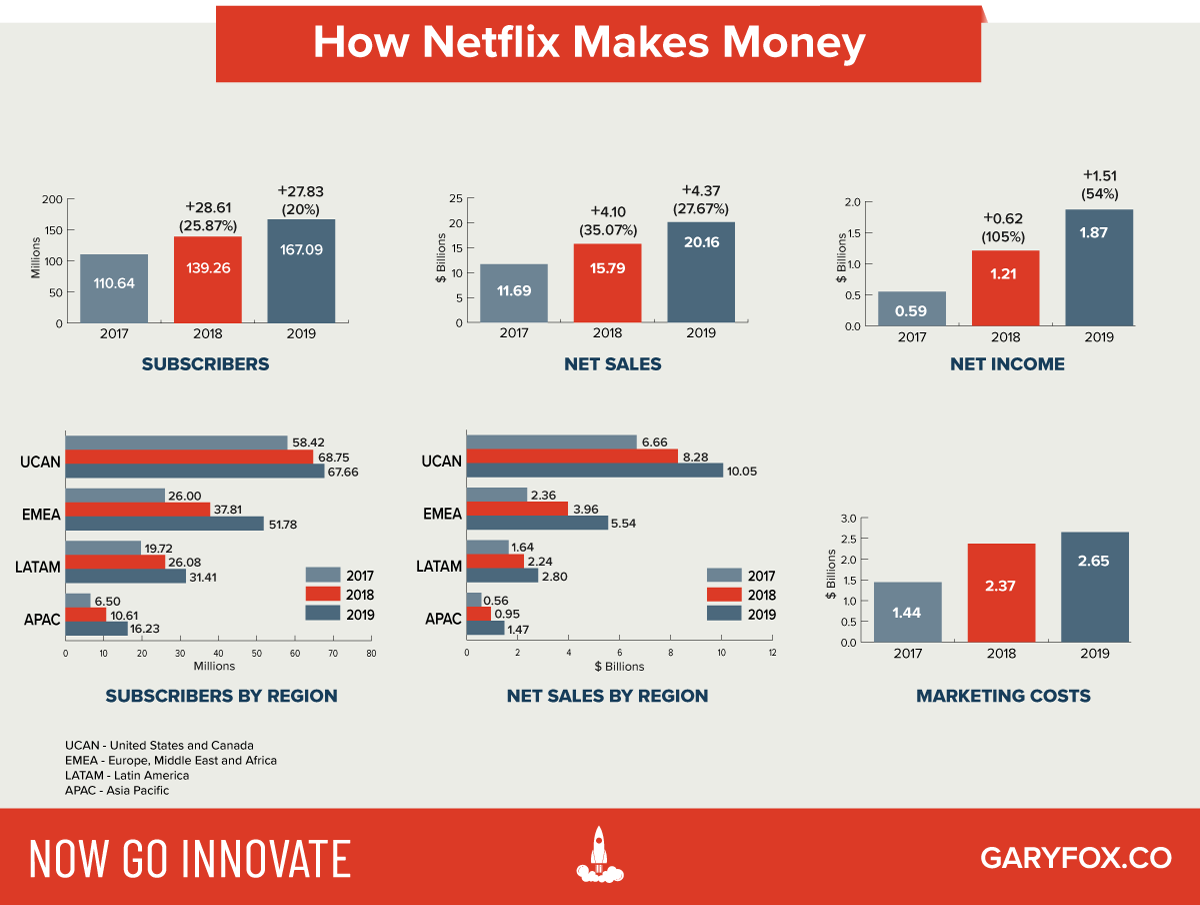The Netflix business model has been replicated by competitors and while the US market growth slows competition for developing markets like India is hotting up.
How well-positioned is Netflix to fend off competitors and will it continue to show strong growth?
I’ll examine the Netflix business model and some of its key financials.
Let’s start with Netflix’s background and how it became such a dominant global player in the video streaming sector.
The Netflix business model is a platform that offers on-demand video streaming for a subscription fee. An initial hook is to provide people with one free month as a trial period, or more recently, Netflix is being bundled with mobile packages.
Netflix offers non-linear viewing. Linear viewing is a term used to watch content during broadcasts. Non-linear is on-demand viewing.
Netflix competes in the subscription video-on-demand market. A quick overview will help you understand some of the trends shaping Netflix’s business model and performance.
Table of Contents
The Subscription Video-On-Demand Market
Subscription video-on-demand (SVoD) is increasing globally, and this trend will help Netflix.

There is a strong trend to video-on-demand streaming, as an example 48% of all United States consumers stream television content every day or week.
Players like Netflix releasing a complete series at once also increases the amount of time spent on their platforms—referred to as binge-watching.

Despite the trends, there are significant regional differences, often due to available technologies and bandwidth.

A key challenge for Netflix in the US and Canada markets which are, at the moment, the largest markets. New entrants such as Disney could possibly erode market share.
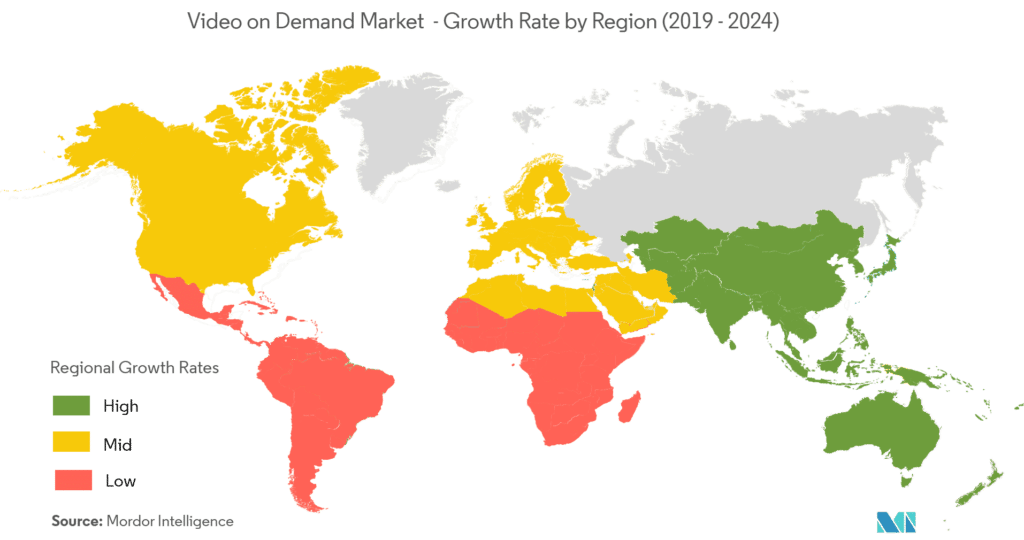
According to Mondor Intelligence, the Video on Demand Market was valued at USD 56.55 billion in 2019 and is expected to reach USD 120.91 billion by 2025, at a CAGR of 13.5% over the forecast period 2020 – 2025.
NetFlix – Quick Facts
Netflix
Reed Hastings and Marc Randolph
Reed Hastings
1997
Reed Hastings
Los Gatos, USA
(FY 2019): 8,600
NLFX
2023: $33.7 billion
2019: $5.4 billion
(April, 2020): $286.7 billion
NetFlix History and Key Timeline

Today, we take Netflix’s on-demand business model for granted. But Netflix’s journey started back in 1997. Reed Hastings and Marc Randolph started offering video rentals as a service through the Internet and then mailing DVDs.
However, within two years, Netflix pivoted to a monthly subscription, allowing customers to access unlimited DVD rentals.
As internet bandwidth grew, Netflix saw the opportunity to transform its business model and offer video streaming. Having made significant investments in the development of a platform, Netflix launched its streaming service in 2007.
Key Milestones in the History of Netflix
- 1997: Netflix was founded by Reed Hastings and Marc Randolph as a DVD rental-by-mail service. It allowed customers to rent DVDs and have them delivered to their homes.
- 1999: Netflix introduced a subscription model, allowing customers to rent unlimited DVDs for a flat monthly fee, without due dates or late fees.
- 2007: Netflix launched its streaming service, allowing customers to watch movies and TV shows online without waiting for DVD delivery. This marked a pivotal shift towards the platform’s future focus on streaming content.
- 2012: Netflix began producing original content, starting with the political drama Lilyhammer. This was followed by House of Cards in 2013, which significantly boosted its subscriber base.
- 2016: Netflix expanded globally, launching in over 130 countries, making it a truly international streaming service.
- 2018: Netflix surpassed HBO in the number of Emmy nominations, highlighting the success of its original programming strategy.
- 2022: For the first time in over a decade, Netflix saw declining subscriber growth. The company responded by introducing an ad-supported tier and enforcing stricter rules around password sharing.
Subscriber Base of Netflix
As of mid-2024, Netflix has nearly 278 million subscribers worldwide. This growth includes an increase of 8.05 million new subscribers in the second quarter of 2024 alone. Netflix’s subscriber base has seen significant expansion, particularly after introducing an ad-supported plan and enforcing stricter password-sharing rules.
Business Model Map of Netflix

Netflix Business Model Canvas
Another way to examine the Netflix business model is to use the now-famous business model canvas. To learn more about using the business model canvas, follow the link.

The Netflix business model involves acquiring and producing content and then distributing it via its platform. What makes it appealing is that it offers on-demand viewing and personalization.
Netflix harnesses the power of the subscription business model to gain regular and repeat revenue.
Netflix Business Model Key Partners
- Investors – the range of investors who provide access to money.
- Media producers – media producers who then license content to Netflix.
- Filmmaker guilds – Directors, actors, writers, and their guilds/unions are some of the most powerful players in the (US) film industry.
- Cinemas and theaters – a new and possibly exciting trend.
- TV networks – who license their IP to Netflix for their own content creation.
- Consumer electronic producers – who bundle Netflix with their systems e.g. Sony Playstation.
- Amazon AWS – The whole Netflix technology platform is hosted on Amazon AWS.
- Regulators – Policies of the Federal Communications Commission (FCC), esp on the topic of net neutrality can have a crucial influence on Netflix.
- Key Activities
- Technology R&D – As technology keeps changing Netflix needs to invest in and renew its tech stack continually.
- Content licensing – To remain relevant and appeal to its 2000 micro-segments Netflix needs to continually select and purchase content.
- Content production – Since 2013 Netflix has produced its own content – Netflix originals.
- Content distribution – the optimization of video streaming across the globe.
- Data analytics – analytics to constantly understand customer behavior to improve the overall user experience and hence reduce churn.
- Sales and marketing – to grow customers at the lowest cost possible but optimizing with the right customer fit – to maximize CLV.
According to a report by Barclays, Netflix’s U.S. partnerships add about 1.2 million domestic subscribers per year.
Netflix Business Model Key Resources
- Brand – they rank in the top 100 global brands.
- Apps/Website – the main channel for content delivery.
- Platform – the analytics and overall system for delivery, customer personalization and streaming.
- Employees – general staff plus technical staff who maintain and develop the platform.
- Filmmakers/producers – their relationship with leading writers and producers.
- Prizes/Awards – nominations help promote their content to a global audience.
- Content library – a huge catalogue of content. Their content could be licensed in the future.
- Studios: Netflix is creating its own studios and to support its content creation.
Netflix Business Model Value Proposition
- Content library – access to a huge library of content to suit all needs.
- On-demand streaming – anytime, any device streaming.
- Binge Watch – watch a whole season in one go.
- Original content – e.g. The Witcher.
- Localization – Orginal local content as well as licensed content.
- Free one-month trial – free trial with no restrictions.
- Low-monthly pricing – this depends on the economy of each Country (see later).
- Personalization – create lists and also get recommendations.
Netflix Business Model Customer Segments
- Micro-segmentation – 2000 taste clusters.
- Usage segmentation – screens used, where used, how often used, when…
- Geographical segmentation – used for ad targeting, localization of content.
Netflix Business Model Customer Relationships
- Self-service – customers access services via the app.
- Personalization – tailored content and lists.
- User support – via live chat, email or call.
Netflix Business Model Channels
- Any device
- Netflix App
- PR/Word of Mouth
- Online Advertising
- Offline Advertising
- Social Media
Netflix Business Model Revenue Streams
- Subscription Model – Netflix’s main source of revenue.
- Product Placement – marginal earnings not significant.
- DVD Rental – still a revenue stream but becoming less important.
- Licensing own content – possible future income.
- Ads – for free viewers.
Partnering To Improve Netflix Subscriptions
To improve the partner’s part of the Netflix business model, Netflix has expanded partnerships to include cable, home internet, and mobile carriers. The goal of these partnerships is to improve the uptake of subscriptions.
According to a report by Barclays, Netflix’s U.S. partnerships add about 1.2 million domestic subscribers per year.
Customers who use two or more phone lines on their unlimited data plan are eligible for a free Netflix subscription.
Beyond its deals with T-Mobile and Comcast, Netflix also has an opportunity to make more bundling deals with pay-TV distributors.
Our business model is subscription based as opposed to a model generating revenues at a specific title level. Therefore, content assets, both licensed and produced, are reviewed in aggregate at the operating segment level when an event or change in circumstances indicates a change in the expected usefulness.
Netflix
How Netflix Makes Money
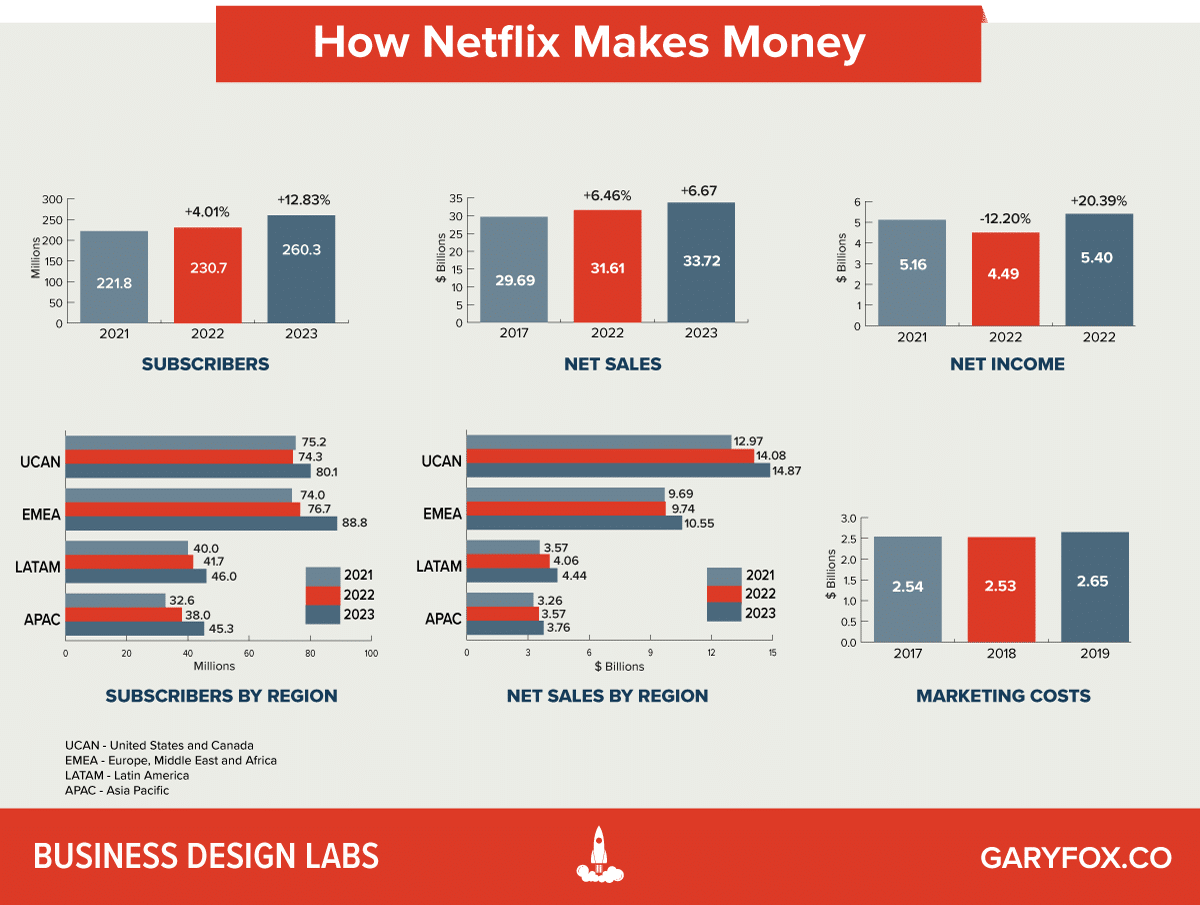
Netflix Revenue Model – Monthly Membership Fees
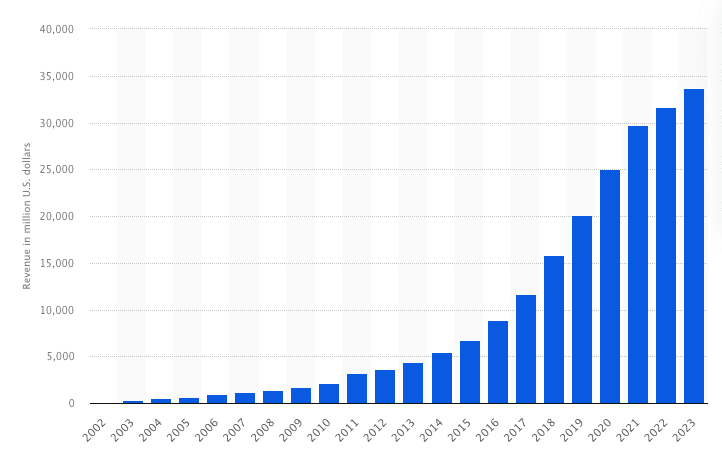
The main source of revenue is subscriptions. Netflix offers three different plans for users based on the streaming quality of the content provided:
• Basic – content can be streamed in Standard Definition.
• Standard – content can be streamed in High Definition.
• Premium – content can be streamed in Ultra High Definition.
The costs of these plans differ in different countries.
Netflix continues to show strong growth across all regions, but there are concerns over the US market and its potential to grow further. The concerns involve the heavier cost of customer acquisition in the US and the more intense competition from Disney+, Amazon Prime, and HBO.

Following a challenging year for the U.S. TV and streaming industry due to Hollywood strikes, market leader Netflix reported a net income exceeding 2.1 billion U.S. dollars in the second quarter of 2024, an increase from the previous year. Its revenue and subscriber base also grew, surpassing expectations.
The Netflix Business Model – Content Investments
We acquire, license and produce content, including original programing, in order to offer our members unlimited viewing of TV shows and films.
Netflix
The content liabilities are due to the high cost of purchasing content from third parties and commissioning content for Netflix originals. The need to continually renew content to maintain customer loyalty is a key factor in Netflix’s business model.
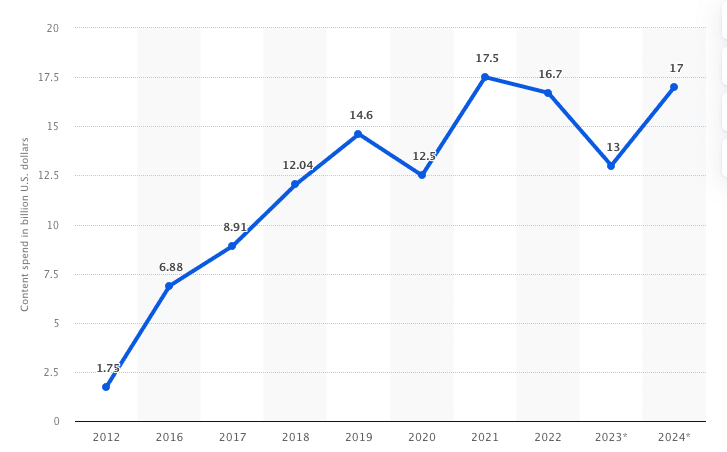
Netflix Customer Metrics
As with all subscription business models, understanding the key financial drivers is critical to success.
Subscribers
- Global Paid Memberships: At the end of 2023, Netflix had 260.3 million paid memberships, compared to 230.7 million in 2022, reflecting a 13% increase.
- Paid Net Membership Additions: In 2023, Netflix added 29.5 million new paid memberships, a significant increase from the 8.9 million added in 2022.
- Average Paying Memberships: The average number of paying memberships in 2023 was 240.9 million, up from 222.9 million in 2022.
- Average Monthly Revenue per Membership: The average revenue per membership was $11.64 in 2023, slightly down from $11.76 in 2022.
- Total Streaming Revenue: Netflix generated $33.6 billion from streaming services in 2023, representing a 7% increase from the $31.5 billion earned in 2022.
Regional Membership Breakdown:
- Asia-Pacific (APAC): 45.3 million paid memberships, generating $3.76 billion in revenue(Netflix-10-K-01262024).
- United States and Canada (UCAN): Paid memberships rose to 80.1 million, with $14.87 billion in revenue, and an average monthly revenue per member of $16.28(Netflix-10-K-01262024).
- Europe, Middle East, and Africa (EMEA): 88.8 million paid memberships, generating $10.56 billion in revenue(Netflix-10-K-01262024).
- Latin America (LATAM): 46 million paid memberships, with $4.45 billion in revenue(Netflix-10-K-01262024).
Average Revenue Per User (ARPU)
- Global ARPU: $11.64 in 2023, down slightly from $11.76 in 2022.
Regional ARPU:
- United States and Canada (UCAN): $16.28 in 2023.
- Europe, Middle East, and Africa (EMEA): $10.87 in 2023.
- Latin America (LATAM): $8.66 in 2023.
- Asia-Pacific (APAC): $7.64 in 2023.
Netflix Customer Acquisition Cost (CAC) and Customer Lifetime Value (CLV)
The key measures that drive the profitability of the Netflix business model and other subscription models are:
Today, we are going to look at a number of metrics that are being used in the context of assessing companies’ growth potential:
- CAC: Customer Acquisition Cost.
- CLV (or LTV): Customer LifeTime Value.
- ARPU: Average Revenue per User
- Churn rate.
These measures can then be used for further metrics, such as the ratio of customer acquisition (CAC) to lifetime value, which measures how much value is derived from a customer over the time they subscribe.
Netflix Cost of Acquisition (CAC)
The calculation for CAC = All costs related to acquiring new customers/number of new customers.
Simplified CAC = marketing costs/number of new customers.
In 2023, Netflix spent approximately $2.66 billion on marketing activities. During the same period, 29.5 million new subscribers were added, so the Customer Acquisition Cost (CAC) is calculated by dividing the total marketing spend by the number of new customers.
This results in a CAC of $90.17 per subscriber, indicating how much Netflix invests, on average, to acquire each new customer.
However, this doesn’t account for churn. Considering the number of users, Netflix also needs to make up for the losses through churn.
What is the churn rate of Netflix?
Assuming Netflix’s churn rate is 9%, then the CAC is lower.
The adjusted Customer Acquisition Cost (CAC), taking into account the churn rate of 9%, is approximately $99.09.
Netflix Customer Lifetime Value
The average revenue per user (ARPU) is simply the total income / the number of users.
To estimate the Customer Lifetime Value (CLV), we use Netflix’s global Average Revenue Per User (ARPU) of $11.64 per month, a gross margin of 40%, and an estimated churn rate of 2%.
If Netflix spends an average of $90.17 to acquire a customer, we want to know when that cost is recovered and how long a customer stays to ensure profit. First, we need to know the gross profit per user.
Gross profit per user = revenue per user – cost of revenue per user.
The final calculation then is LTV = Gross profit per user / churn rate.
For the table below I have assumed a churn rate of 9.8% (Netflix does not reveal churn rate).
| Metric | 2023 Figures |
| ARPU (annual) | $139.68 |
| Cost of Revenue Per User | $83.81 (calculated using a 40% gross margin) |
| Gross Profit Per User | $55.87 |
| Churn Rate | 9.8% |
| LTV | $2,234.88 |
It is worth noting that some analysts place the churn rate much higher than 9.8% and closer to 20%. That would substantially change the dynamics of the above equation and effectively half the customer lifetime value.
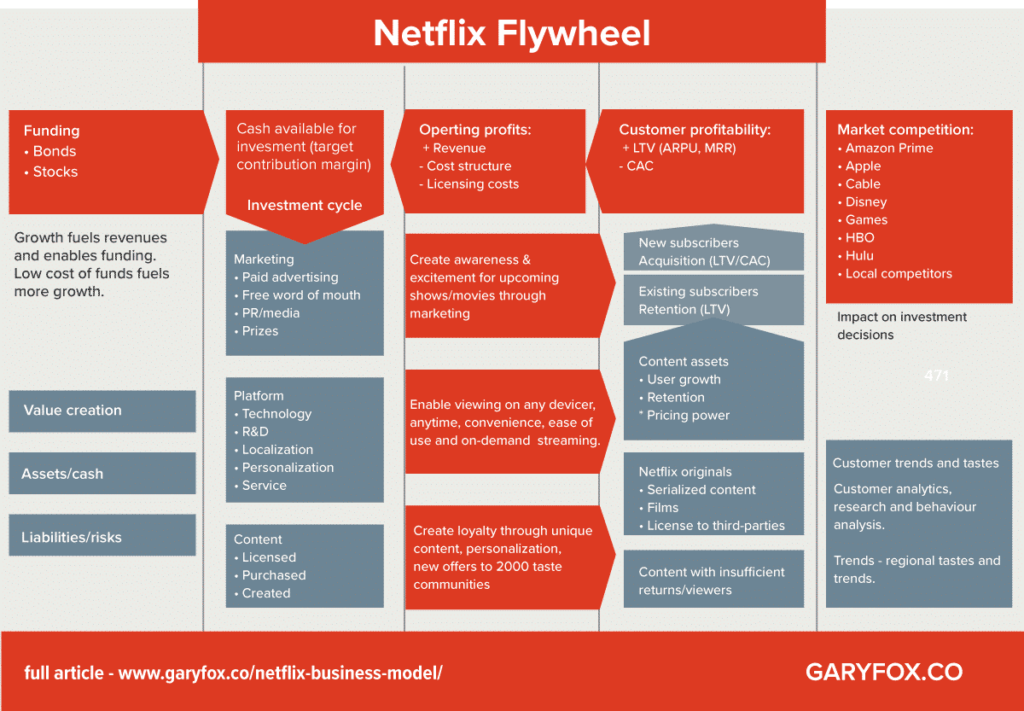
Netflix Cash Flow
The updated information from the 2024 Netflix report indicates significant improvements in Free Cash Flow (FCF). For 2023, Netflix reported $6.93 billion in free cash flow, a massive increase from the previous year’s $1.62 billion
Netflix end of year report – January 2023
As of the end of 2023, Netflix’s long-term debt amounted to $14.543 billion, reflecting a slight increase of $190 millioncompared to 2022. This was primarily due to the remeasurement of euro-denominated notes. Netflix has consistently utilized debt markets to fund its substantial content investments.
Improving Cashflow
Netflix said cash burn peaked last year and it expects to achieve free cash flow positive in the future. During the fourth-quarter earnings call, Netflix CEO Reed Hastings said the positive cash flow won’t come from scaling back spending on content, but rather from increases in revenue and operating income.
In contrast to the earlier years when Netflix raised $1 billion of senior notes at 4.875% and €1.1 billion at 3.625%, both due in 2030, the company now focuses more on cash flow improvements. With over $6.93 billion in free cash flow for 2023, Netflix’s financial outlook has shifted positively, reducing the need for heavy reliance on debt
Netflix International Expansion
Netflix’s international expansion strategy has remained central to its growth, with a focus on scaling across various regions and addressing local market challenges.
As of 2023, Netflix operates in over 190 countries, with over 260 million paid memberships globally.
A substantial portion of Netflix’s subscriber base now comes from markets outside the U.S., such as the Europe, Middle East, and Africa (EMEA) region, which accounts for approximately 88.8 million paid memberships, and Asia-Pacific (APAC), which continues to show strong growth.
Netflix India
India’s streaming video market, already among the most competitive, is expected to grow rapidly in the coming years.
This is largely due to factors such as affordable mobile data, increasing smartphone usage, and a young, tech-savvy population.
Disney+ Hotstar continues to dominate, holding a 29% market share with over 50 million subscribers in India as of early 2023.
Its position is bolstered by regional content and exclusive sports rights like the Indian Premier League (IPL), although the company recently decided not to renew its IPL digital rights, focusing more on profitability and increasing ARPU (Average Revenue Per User).
In comparison, Netflix holds a smaller portion of the Indian market, with a 5% market share, but earns a significant portion of the streaming revenue in India, primarily due to its premium pricing strategy. T
he company is increasingly investing in local content and reducing prices to attract more subscribers in the highly price-sensitive Indian market.
As the market expands, players like Disney+ Hotstar and Netflix are adjusting strategies to maintain competitiveness, particularly in content spending and subscriber growth. By 2027, the Indian OTT market is expected to reach $7 billion, driven by increased demand for both regional and international content.
Netflix Competition
Disney Plus might be the new kid on the block, but it’s wasted no time in attracting 28.6 million paid subscribers, according to CEO Bob Iger during the company’s first-quarter earnings call.
That may not seem like a lot when compared to Netflix’s 167 million subscribers, but to put it in context, Disney Plus has been around for less than three months, while Netflix has been streaming movies and TV shows for 12 years.
Amazon, the behemoth platform which has Amazon Prime, is also and is intent on acquiring market share.
How The Video Streaming Platforms Differ
| Company | Netflix | Disney | Fox, Sky | YouTube | HBO |
| Offer | Stories, unique content and entertainment | Big blockbusters and family experience | News and Sports + Entertainment | Information, education + entertainment | Niche Shows and Series |
| Business Model | Subscription | Subscription + Disney flywheel | Ads and affiliate fees | Ads/Subscription | Ads/Subscription |
- Disney+:
- Amazon Prime Video:
- Amazon is projected to spend around $50 per user on content in 2023, compared to Netflix’s over $70 per user(MediaBrief).
- Despite Netflix’s larger investment in content, Amazon Prime Video competes by bundling its streaming service with other perks, such as fast shipping for e-commerce. As of 2024, Prime Video remains one of the top platforms, especially in markets like India where it holds a 19% market share(Beebom).
- Warner Bros. Discovery:
- In Q2 2024, Warner Bros. Discovery’s streaming services (Max, HBO, HBO Max, Discovery+) had over 103 million global subscribers(Finance India).
- The U.S. and Canada remain the largest markets for Warner Bros. Discovery, despite a slight decline in subscriber numbers. Its diversified content offering includes high-profile titles such as Game of Thrones and popular documentaries.
- Apple TV+:
- Apple TV+ has been growing steadily, with 834,000 new subscribers reported in July 2023, partly due to content partnerships like Major League Soccer(Finance India).
- Although smaller in scale compared to competitors, Apple TV+ continues to attract subscribers through premium content offerings, such as the critically acclaimed series “Ted Lasso” and exclusive film releases.
- Major League Soccer (MLS) and Apple:
- The MLS streaming platform saw significant growth between June and July 2023, with over 288,000 new users signing up during that period(
- Finance India).This partnership with Apple TV+ has further boosted Apple’s visibility and subscriber base, especially in sports streaming.
Netflix business strategy
There is no doubt that the wheels won’t fall off Netflix and it is in a strong position. No other player in the market has the same global reach or scale. However, as with many markets, the danger is losing market share to multiple players and potential new entrants.
- Netflix is focused on reaccelerating growth by continuing to release high-quality films, series, and games that engage their members globally. The company also addressed account sharing across all jurisdictions and expanded its advertising offerings to appeal to both consumers and advertisers (Netflix 2024 proxy report).
- Netflix is committed to enhancing its lower-priced ad-supported subscription plan, which aims to attract a broader audience while simultaneously improving the value proposition for advertisers. The company’s strategy also includes tighter enforcement on account sharing to increase paid memberships (Netflix 2024 proxy report).
- A key component of Netflix’s growth strategy is expanding its content offerings across different genres and languages, demonstrating that “great stories come from anywhere” and resonate with audiences globally. The company has broadened its offerings to include live events and continues to explore consumer products and live experiences as a way to deepen connections with fans (Netflix 2024 proxy report).
Summary of the Netflix Business Model
The company’s big advantage over its streaming competition is its scale. Netflix’s 260.3 million global subscribers receive an annual run rate of about $37.3 billion. That has allowed Netflix to invest heavily in content last year, and even more is expected to be invested this year.
Netflix’s international expansion is costing billions of dollars, and this needs to continue as US market growth slows and competition intensifies.
